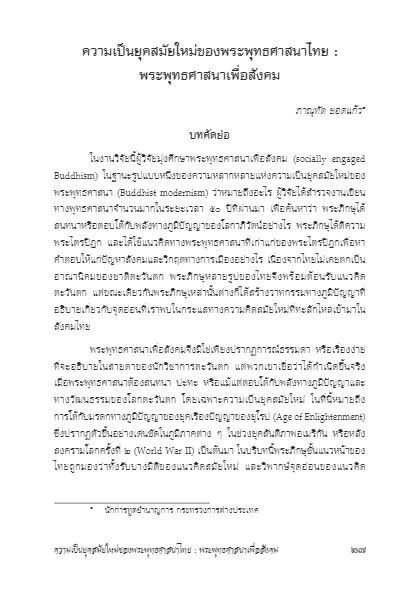ภาณุทัต ยอดแก้ว
บทคัดย่อ
ในงานวิจัยนี้ผู้วิจัยมุ่งศึกษาพระพุทธศาสนาเพื่อสังคม (socially engaged Buddhism) ในฐานะรูปแบบหนึ่งของความหลากหลายแห่งความเป็นยุคสมัยใหม่ของพระพุทธศาสนา (Buddhist modernism) ว่าหมายถึงอะไร ผู้วิจัยได้สำรวจงานเขียนทางพุทธศาสนาจำนวนมากในระยะเวลา 50 ปีที่ผ่านมา เพื่อค้นหาว่า พระภิกษุได้สนทนาหรือตอบโต้กับพลังทางภูมิปัญญาของโลกาภิวัตน์อย่างไร พระภิกษุได้ตีความพระไตรปิฎก และได้ใช้แนวคิดทางพระพุทธศาสนาที่เก่าแก่ของพระไตรปิฎกเพื่อหาคำตอบให้แก่ปัญหาสังคมและวิกฤตทางการเมืองอย่างไร เนื่องจากไทยไม่เคยตกเป็นอาณานิคมของชาติตะวันตก พระภิกษุหลายรูปของไทยจึงพร้อมต้อนรับแนวคิดตะวันตก แต่ขณะเดียวกันพระภิกษุเหล่านั้นต่างก็ได้สร้างวาทกรรมทางภูมิปัญญาที่อธิบายเกี่ยวกับจุดอ่อนที่เราพบในกระแสทางความคิดสมัยใหม่ที่ทะลักไหลเข้ามาในสังคมไทย
พระพุทธศาสนาเพื่อสังคมจึงมิใช่เพียงปรากฏการณ์ธรรมดา หรือเรื่องง่ายที่จะอธิบายในสายตาของนักวิชาการตะวันตก แต่พวกเขาเชื่อว่าได้กำเนิดขึ้นจริง เมื่อพระพุทธศาสนาต้องสนทนา ปะทะ หรือแม้แต่ตอบโต้กับพลังทางภูมิปัญญาและทางวัฒนธรรมของโลกตะวันตก โดยเฉพาะความเป็นยุคสมัยใหม่ ในที่นี้หมายถึงการโต้กับมรดกทางภูมิปัญญาของยุคเรืองปัญญาของยุโรป (Age of Enlightenment) ซึ่งปรากฏตัวขึ้นอย่างเด่นชัดในภูมิภาคต่างๆ ในช่วงยุคสันติภาพอเมริกัน หรือหลังสงครามโลกครั้งที่ 2 (World War II) เป็นต้นมา ในบริบทนี้พระภิกษุชั้นแนวหน้าของไทยถูกมองว่าทั้งรับบางมิติของแนวคิดสมัยใหม่ และวิพากษ์จุดอ่อนของแนวคิดสมัยใหม่เหล่านั้น แต่ขณะเดียวกันพระก็ยังสามารถรักษาแก่นคำสอนทางพระพุทธศาสนาของตนไว้ วาทกรรมของการปะทะกับพลังทางภูมิปัญญาของตะวันตกยังคงดำเนินอยู่และได้มีผลต่อความเข้าใจของพวกเราเกี่ยวกับพระพุทธศาสนาในปัจจุบัน ในงานวิจัยนี้ผู้วิจัยพบว่า การแข่งขันกับแนวคิดสมัยใหม่ของโลกตะวันตก ความล้มเหลวของสถาบันต่างๆในสังคมไทย และการรุกคืบของการเผยแพร่คำสอนของคริสตจักรในประเทศไทยเป็นปัจจัยสำคัญที่ทำให้พระพุทธศาสนาเพื่อสังคมต้องเกิดขึ้นในประเทศไทย
คำสำคัญ : ความเป็นยุคสมัยใหม่ของพระพุทธศาสนา, พระพุทธศาสนาเพื่อสังคม, ยุคสันติภาพอเมริกัน
(ตีพิมพ์ใน วารสารไทยศึกษา ปีที่ 13 ฉบับที่ 1 (มกราคม – มิถุนายน 2560) หน้า 27-54)
Thai Buddhist Modernism : Socially Engaged Buddhism
Panutat Yodkaew
Abstract
In this research, Panutat Yodkaew aims to study what the term “socially engaged Buddhism” as part of the wider spectrum of the so called “Buddhist Modernism” actually means. He explore hundreds of pieces of writing over the past 50 years to see how Buddhist monks reacted to the intellectual force of globalization, how they interpreted the Tripitaka and applied ancient Buddhist thoughts therein to find solutions for social malaise and political crisis confronting Thailand. Due partly to the fact that Thailand has never been colonized by the West, several Thai Buddhist monks are keen to welcome various strands of Western thoughts while at the same time constructing their own versions of intellectual discourses and rhetoric, particularly in relation to what they deem as weak points found in those various modern thoughts and concepts penetrating Thai society.
Socially engaged Buddhism is not a common or easy-to-explain phenomenon for Western academia but this kind of Buddhism was formed when well educated Buddhist monks conversed, confronted and even reacted to the intellectual legacy of the Age of Western Enlightenment that figured predominantly during the rise of Pax Americana following the end of the World War II. In this context, Thailand’s leading Buddhist monks are perceived as negotiating the tension between adopting aspects of western modernity and critiquing them while maintaining what is viewed as the core Buddhist teachings. The discourses of their encounter with the West are still evolving and shaping our understanding of what Buddhism is about. In his research findings, Yodkaew shows that the perceived competition between Buddhism and Christianity and other modern concepts over the past sixty years gave rise to Thailand’s socially engaged Buddhism.
Keywords : Buddhist Modernism, socially engaged Buddhism, Pax Americana
(Published in Journal of Thai Studies Volume 13 Number 1 (January – June 2017) Page 27-54)
บทความ / Full Text : Download
